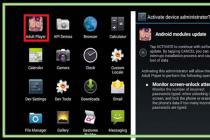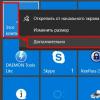For work in Russian 4G LTE networks, most of the American operator versions are not suitable due to the inconsistency of the frequency ranges.
Interestingly, Samsung decided to skip the SM-G940X and SM-G945X model number ranges (the Galaxy S7 and S7 Edge were classified as SM-G930X and SM-G935X). The exact reason for this is not known.
SM-G9500
Modification for the Chinese market, smartphones are not initially blocked to work in the networks of only any operator. Chipset based Qualcomm Snapdragon 835. Supports Dual-SIM, CDMA 800 MHz 2G / 3G and TD-SCDMA 3G.
SM-G9508
Modification for sale in Taiwan Island and probably Hong Kong. Also based on Snapdragon 835 and has Dual-SIM support.
SM-G950A
Operator model for the American operator AT&T, smartphones are initially locked to work exclusively in networks this operator... Based on the Snapdragon 835 chipset. There is no Dual-SIM support.
SM-G950AZ
Option for US sub-operator Cricket Wireless, which is now a subsidiary of AT&T giant. Locked, based on Snapdragon 835, no Dual-SIM.
SM-G950D
Operator model for the Japanese operator NTT Docomo, smartphones are initially blocked to work only in the networks of this operator. Presumably Exynos 8895.
SM-G950F and SM-G950FD
Major international versions based on Exynos 8895. In the SM-G950FD variant, Dual-SIM support is present initially, and part of the SM-G950F also has it. Will be certified for sale in Russia.
SM-G950J
SM-G950K
Most likely, this is a camera model for a South Korean operator mobile communications Korea Telecom. Based on Exynos 8895 chipset.
SM-G950L
Another modification especially for South Korea. Operator model for work in LG U + networks. Based on Exynos 8895 chipset.
SM-G950P
Operator model for Sprint operator from the USA, smartphones are initially blocked to work only in its networks. No Dual-SIM, based on Qualcomm Snapdragon 835.
SM-G950R and SM-G950R4
For the American operator U.S. Cellular, smartphones are initially locked to work on its networks. CDMA / CDMA 2000 and 4G LTE only. Qualcomm Snapdragon 835.
SM-G950R6
Presumably a special version Samsung Galaxy S8 for Verizon's LTE in Rural America (LRA) project, which involves the development of 4G networks in rural areas and small cities. Qualcomm Snapdragon 835.
SM-G950R7
Modification of Galaxy S8 for C Spire Wireless (USA). There is probably support for CDMA 2000. Qualcomm Snapdragon 835.
SM-G950S
SM-G950T
Another "American", also an operator version, to work in the networks of the T-Mobile operator. Most likely, it will be based on the Qualcomm Snapdragon 835 chipset. There is no Dual-SIM.
SM-G950T1
For sub-operator MetroPCS, which is a partner of T-Mobile (currently time is running T-Mobile's gradual takeover of MetroPCS). Qualcomm Snapdragon 835. Dual-SIM no.
SM-G950V
American, operator version, for Verizon. Qualcomm Snapdragon 835. Dual-SIM no.
SM-G950W and SM-G950W8
For the Canadian operator Bell Mobility. Exynos 8895.
Presumably Samsung Galaxy S8 Plus
This range of model numbers, in all likelihood, was originally intended for the Galaxy S8 Edge. However, Samsung decided to equip both variants with a curved screen this time around. So instead of the Plus, there will be an Edge.
SM-G9550
Model for the domestic Chinese market without any operator reference. Most likely, it will be based on the Qualcomm Snapdragon 835 chipset.
SM-G955A
Presumably the operator's model for the American operator AT & T, smartphones were initially blocked to work exclusively in the networks of this operator. Most likely, it will be based on the Qualcomm Snapdragon 835 chipset.
SM-G955AZ
Presumably a model for the US sub-operator Cricket Wireless, which is currently a subsidiary of AT&T. Most likely, it will be based on the Qualcomm Snapdragon 835 chipset.
SM-G955D
Presumably the operator's model for the Japanese operator NTT Docomo, smartphones are initially blocked to work exclusively in the networks of this operator. Most likely, it will be based on the Exynos 8895 chipset.
SM-G955F and SM-G955FD
The main Samsung model Galaxy S8 Plus for Europe. It is based on the Exynos 8895 chipset. More precise information on the countries where it will be presented is not yet available. Most likely, this particular model will be sold to Russia.
SM-G955J
Presumably operator model for Japanese operator KDDI. By default, smartphones are locked for use exclusively on KDDI networks. Most likely, it will be based on the Exynos 8895 chipset.
SM-G955K
Most likely, this will be the carrier model for the South Korean mobile operator Korea Telecom. Based on Exynos 8895 chipset.
SM-G955L
This is probably also an operator model, but for another South Korean mobile operator - LG U +. Based on Exynos 8895 chipset.
SM-G955P
Presumably the operator's model for the American operator Sprint, smartphones are initially blocked to work exclusively in the networks of this operator. Most likely, it will be based on the Qualcomm Snapdragon 835 chipset.
SM-G955R and SM-G955R4
Presumably operator model for U.S. operator U.S. Cellular, smartphones are initially blocked to work exclusively on the networks of this operator. Most likely, it will be based on the Qualcomm Snapdragon 835 chipset.
SM-G955R6
A special version of the Samsung Galaxy S8 Plus for Verizon's LTE in Rural America (LRA) project, which involves the development of 4G networks in rural areas and small cities, where usually modern technologies come last. Most likely, it will be based on the Qualcomm Snapdragon 835 chipset.
SM-G955R7
Galaxy S8 Plus variant for sub-operator C Spire Wireless (USA). It will probably support CDMA 2000 networks. Most likely, it will be based on the Qualcomm Snapdragon 835 chipset.
SM-G955S
Operator model for work in the networks of the Korean operator SK Telecom, smartphones are initially blocked to work exclusively in the networks of this operator. Most likely, it will be based on the Exynos 8895 chipset.
SM-G955T
Another "American", also an operator version, to work in the networks of the T-Mobile operator. Most likely, it will be based on the Qualcomm Snapdragon 835 chipset.
SM-G955T1
Another "American", also an operator option, for MetroPCS, a sub-operator, which is a partner of T-Mobile (T-Mobile is currently in the process of gradually acquiring MetroPCS). Most likely, it will be based on the Qualcomm Snapdragon 835 chipset.
SM-G955V
Another "American", also an operator's version, to work in the networks of the operator Verizon. Most likely, it will be based on the Qualcomm Snapdragon 835 chipset.
In recent years, the number of Samsung's competitors has grown exponentially. If earlier the main rival in the market of mobile devices was only the American Apple, now a lot has been added. good producers from China, Japan and some other countries. Hence, it is not surprising that this brand decided to release a unique smartphone that will be able to compete with both iPhones and devices from other companies. Moreover, Samsung decided to take the market in both quality and quantity. That is why, in March 2017, 2 devices were presented at once: the Samsung Galaxy S8 and its enlarged twin brother, the Samsung Galaxy S8 Plus. How can these gadgets please potential buyers? Let's try to figure it out.
Samsung Galaxy S8 and S8 Plus design
In terms of material, everything remained unchanged. Both new flagships are made of aluminum, with a glass frame on the sides. As for the colors, there is still a minimum of information. But taking into account the fact that the body will be made of aluminum, there is no doubt about the availability of gray and black colors.
The main novelty of the S8 and its improved sibling S8 Plus will be the corners. They will now be slightly rounded. It is easy to guess that this step was due to the desire of the developers to make their new creations as similar as possible to latest versions iPhone. Moreover, relying on the "apple" smartphones versions 7 and 7 Plus, the dimensions of the future Korean flagships were selected. Due to information leaks at the production stage, it became known that the S8 will be almost the same size as the iPhone 7. The S8 Plus model will copy the dimensions of the corresponding version of the iPhone.
More precisely, the approximate dimensions of the 8th "Galaxy" will be as follows:
- width - 68.1 mm;
- height - 148.9 mm.
- width - slightly more than 73 mm;
- height - 169.6 mm.
As for the screen, it will become larger. This result can be achieved by "eliminating" the bottom buttons. These controllers will simply be transferred to the display. Another key will appear on the left side panel. In addition to the volume rocker, there will be a power button for Samsung's proprietary "assistant" called Bixby.
The back panel of smartphones will be used as a standard for the rear camera. However, there will be an innovation. In particular, a fingerprint scanner will be located near the camera. This step is also driven by the desire of engineers to increase the display and relieve the bezel as much as possible. In principle, such an arrangement of the scanner would not raise questions if the sensor were placed in the center. However, it will be at the top. Experienced mobile users already claim that this location will make it inconvenient to blindly search for a sensor. Is it so? The answer will be found out only after the devices are brought to the market.
Galaxy S8 and Samsung Galaxy S8 Plus screen specifications

The two newest Korean flagships will have nearly the same display performance. The only discrepancy concerns the length of their diagonal. So, the developers have announced the following sizes:
- for S8 - 5.8 inches;
- for S8 Plus - 6.2 inches.
The displays of these two gadgets are characterized by high picture clarity and detailed color reproduction. Smoothing the corners will create the illusion of "endlessness" of the screen. In addition, increasing its size will allow you to get more pleasure when surfing the Internet, playing and watching videos.
Specifications Samsung Galaxy S8 and S8 Plus
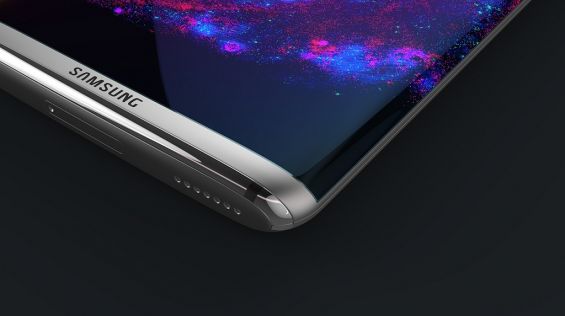
In terms of their performance, the two models under consideration will be identical. The differences will only depend on the area of implementation.
- CPU. Both models will operate on an eight-core chip clocked at 2500 MHz. But the exact name of the processor will depend on the area of sale. So, the markets of the USA, China and Japan will see models powered by a chipset called Qualcomm Snapdragon 835. For Europe and other Asian countries (except for those already mentioned), Exynos 8895 processors are provided. We can say that the Americans, Chinese and Japanese will have a significant advantage in front of European and remaining Asian buyers. The fact is that the Snapdragon 835 chip is designed according to the latest technology supporting the mode Quick charge fourth generation. Such a processor device will provide devices with 5-hour battery life after a 5-minute charge.
- RAM. And again there will be a kind of geographic discrimination. All markets, except for the Chinese and South Korean, will be equipped with gadgets equipped with 4 gigabytes of RAM. But for China and South Korea, there are devices with 6 GB of memory on board. According to some analysts, this is due to the specific mentality of buyers in these countries.
- Inner memory. Here everyone will be equal. Both devices will have around 64GB of internal storage. At the same time, there is information that the integrated drive of the two new models will support the standard called Universal Flash Storage version 2.1. Thanks to this, the intrasystem data exchange will be much faster. Also, loading applications and switching between them will be significantly accelerated.
- Graphics processor. This hardware component will remain unchanged. The Mali G71MP20 chip will be installed on board the devices. It will be enough for smooth opening and playing of modern games.
Samsung Galaxy S8 and S8 Plus multimedia features

The two considered gadgets will be equipped with a rear as well as a front camera. The quality of the first will be 12 megapixels, and the second - 8 megapixels. These values are the same for both the S8 and S8 Plus. It is worth talking about the capabilities of cameras separately, since this is almost the only component in which Samsung has managed to surpass Apple. Most likely, the Koreans will be able to keep the palm this time too.
According to reports, the cameras of the gadgets will be equipped with an improved eye iris sensor. In other words, human eyes will be recognized much faster. The aperture readings will be about 1.7 f.
But the main highlight lies inside the sensor chip. This design element was equipped with dynamic random access memory. Such a device allows the main cameras of smartphones to conduct super slow motion shooting at a frame rate of about 1000 fps. This means that every detail of the filmed process will be captured as clearly as possible (without blurring and distortion). Another important advantage of cameras will be more fast speed records. If we compare this value with the capabilities of "apple" smartphones, then the new brainchilds of Samsung will surpass Apple by 8 times.
Features of the operating system Samsung Galaxy S8 and S8 Plus
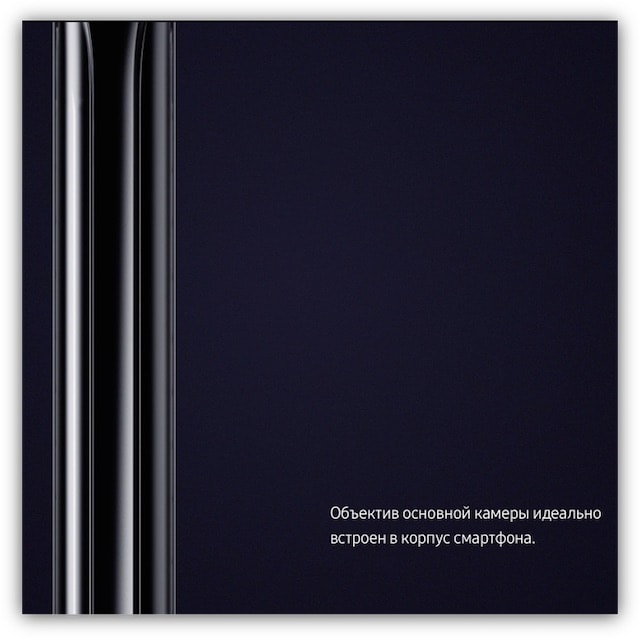
The new Korean flagships will run on the 7th version of Android. This OS is enough to run all modern games and other applications. However, connoisseurs of the colorful interface may be disappointed. Everything will be done as simply as possible. So, the main menu screen will be assigned to:
- information about the weather forecast;
- search line;
- 5 software icons (they will be located under the aforementioned elements).
Autonomy Samsung Galaxy S8 and S8 Plus
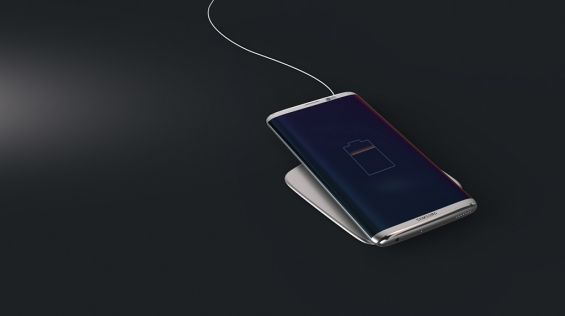
Both gadgets will be equipped with seemingly unpretentious batteries. The battery capacity will be:
- for S8 -3000 mAh;
- for S8 Plus - 3500 mAh.
Additional features of the Samsung Galaxy S8 and S8 Plus
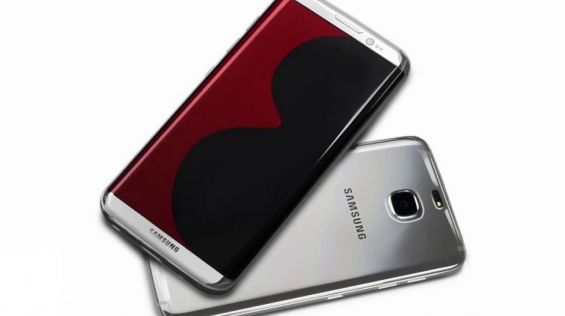
As mentioned above, the left side panel two devices will be equipped with a button that allows you to turn on the electronic Bixby assistant... It may seem that this is a potential competitor to Apple's Siri, but it's not that simple. Siri is a question-and-answer system that plays the role of an online directory. As for Bixby, it is designed to carry out user commands related to the operation of the smartphone itself. For example, using this system, the owner of the gadget will be able to open a photo by voice or send it to a specified addressee (even without opening the phone book).
You might immediately think that this is a very good and useful element of a smartphone, but there is one detail: poor language localization. At this point, Bixby only understands commands spoken in Korean and English... In addition, the list of applications with which the online assistant can work is significantly limited. It is possible that soon Bixby functions will be expanded, but for now it will be of little interest to the domestic user.
Samsung Galaxy S8 and S8 Plus release date, price and video review
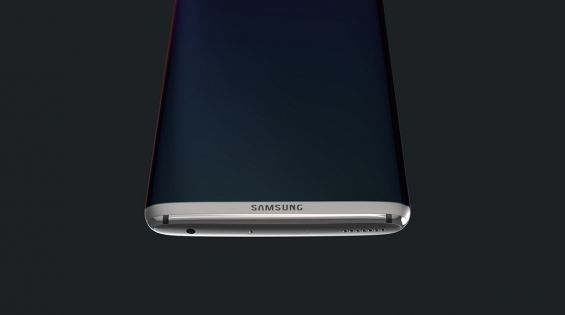
According to available sales information Galaxy phone S8 on the territory of the Russian Federation will begin on April 21. Most likely, the release date of the Samsung Galaxy S8 Plus will be shifted to the very end of the same month.
Now let's talk about cost. Approximate Samsung price Galaxy S8 in Russia will be equal to 54,000 rubles. For the Samsung Galaxy S8 Plus, you will have to pay about 60,000 rubles. Below is a video review that will allow you to once again evaluate all the features of these smartphones:
So we looked at the technical Galaxy characteristics S8 and its twin, Samsung Galaxy S8 Plus, found out their release dates, studied design features. We can assume that these two gadgets have every chance of becoming a serious competitor to the iPhone 8. It is quite possible that some fans of Apple products will even give preference to the Korean flagship. However, we will know the degree of success of the considered models only after the official start of their sales.
On March 29, 2017, the South Korean tech giant Samsung presented its new flagships - Galaxy S8 and S8 Plus. It's worth noting that in the case of the S8 and S8 Plus, the company has outdone itself and is truly confident in its smartphones, so much so that it even raised the starting price of the devices. As far as the price tag is justified, let's figure it out.
In contact with
Design
Most users prefer smartphones with big screen, which is convenient to surf the Web or watch a video. In this regard, the Galaxy S8 (5.8 inches) and S8 Plus (6.2 inches) do not disappoint: the display of the devices is stretched in height - an aspect ratio of 18.5: 9 versus the standard 16: 9.

Samsung has placed six elements on the top bezel, including an iris recognition sensor.
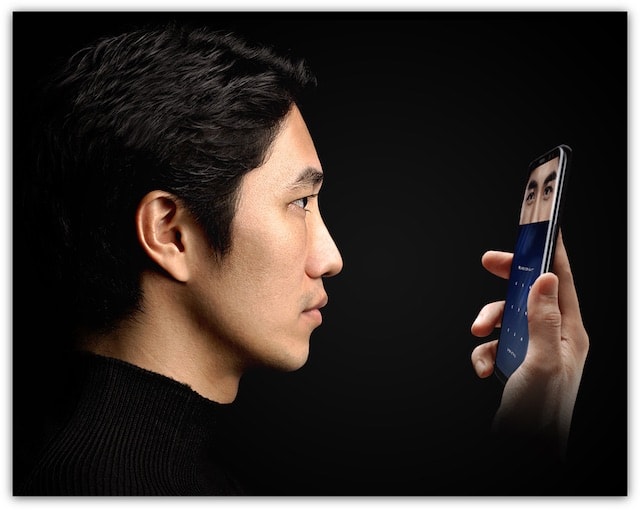
Disappeared in Galaxy S8 and S8 Plus physical button Home, the fingerprint scanner has moved to the back, and the bottom bezel has become even thinner.
Due to the free space under the display, it was possible to increase the screen diagonal. The result is a smartphone with an 83% screen-to-body ratio. The curved edges of the display played a significant role in this, but the curvature here is minimal and serves more for aesthetics than for any functional purposes. Samsung calls this technology Infinity Display and plans to use it in their future flagships.
In the process of manufacturing the glass body, the company used thermoforming and nano-coating technologies. The rear panel of the Galaxy S8 and its curved flexible display are made using 3D Thermoforming technology, the essence of which is to place glass between two special shapes and heat it up to 800 degrees Celsius. After that, under the influence of pressure, the glass will acquire a perfectly symmetrical shape.
Glossy "patterned" body colors are achieved through the use of a nano-thin multi-layer process. The end result of all these technologies is a completely new design. Galaxy series S, in which the Galaxy S8 / S8 Plus have the smallest dimensions in relation to the screen diagonal.
On the Russian site Samsung smartphones The Galaxy S8 / S8 Plus comes in three colors: Black Diamond, Mystical Amethyst, and Yellow Topaz.

Infinity Display
The new models received Super AMOLED displays with a resolution of 2560 × 1440 (WQHD) pixels. The aspect ratio of the screen is 18.5: 9, similar to the LG G6. Part of the screen is occupied by on-screen control buttons, but they are hidden in multimedia applications and games.
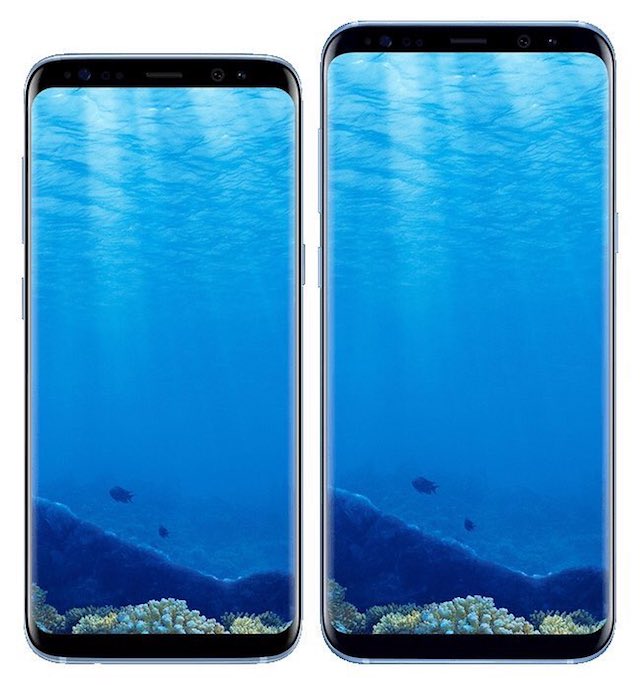
Performance and memory
Like the previous ones Samsung flagships The Galaxy S8 and S8 Plus come in multiple versions for China and the US (running mobile processor Qualcomm Snapdragon 835), and for the rest of the world. The latter is equipped with a proprietary chip Samsung Exynos 8895. A similar situation due to Qualcomm's almost complete monopoly in the US market, which forces other manufacturers to release modified versions of their devices that are compatible with local brands.
Users are unlikely to feel the difference, as both chipsets are quite powerful and are made using a 10nm process technology. The Galaxy S8 / S8 Plus get 4GB of DDR4 RAM, 64GB of internal UFS 2.1 flash, expandable with microSD cards.
Connectivity and connectivity
Galaxy S8 / S8 Plus are the first in the Galaxy S series to receive support USB-C ports, 4G LTE Cat. 16 with 1Gb / s bandwidth and support Bluetooth standard 5.0. As a result, smartphones can download content from the Internet twice as fast, and the range of the Bluetooth signal has quadrupled.
Camera
Samsung has equipped the Galaxy S8 and Galaxy S8 Plus with a 12MP f / 1.7 camera with OIS and an 8MP front-facing module with AF with a similar aperture.
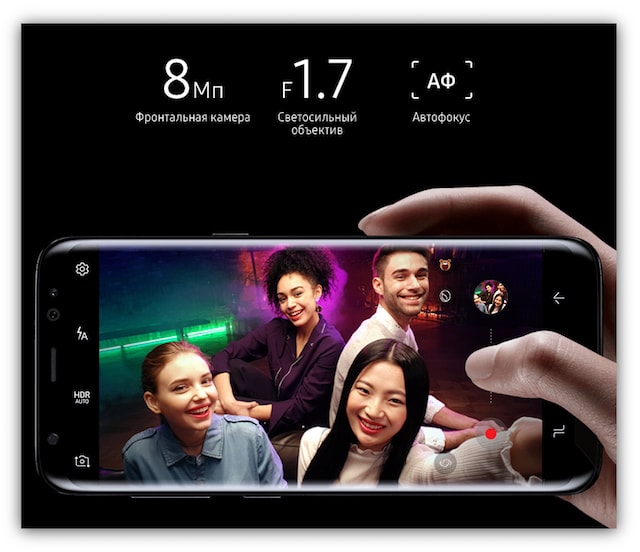
The main Samsung camera Galaxy S8 and S8 Plus do not protrude from the body, as in latest models iPhone.
Battery
The new flagships received batteries with a capacity of 3,000 mAh (S8) and 3,500 mAh (S8 Plus). The manufacturer has managed to improve the time autonomous work devices compared to the S7 and S7 edge through the use of an AMOLED display and Exynos and Snapdragon chips, but only in certain aspects, such as music playback. In the categories of video playback and surfing the Internet, the results demonstrated by the new smartphones are not too different from their predecessors.
Comparison of the battery life of Galaxy S8, Galaxy S8 Plus, Galaxy S7, Galaxy S7 edge:
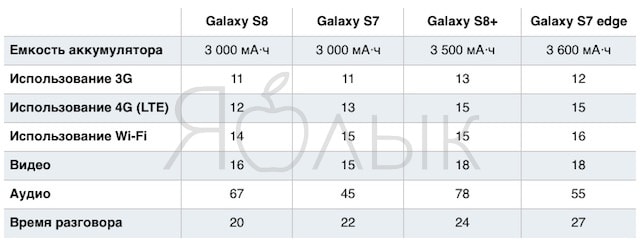
In general, the Galaxy S8 and Galaxy S8 Plus include all the chips that a flagship should have. They are compact and are by far the most powerful Android smartphones on the market. It is quite possible that with the release of the S8 and S8 Plus, Samsung will be able to rehabilitate itself and restore its reputation significantly damaged after the scandal with Galaxy Note 7.
The price of Samsung Galaxy S8 and S8 Plus in Russia
The cost of smartphones at Russian market will be 54,990 rubles for the Samsung Galaxy S8 and 59,990 rubles for
Samsung Galaxy S8 +. The start of sales of the flagship smartphones of the South Korean company in Russia is scheduled for April 28.
What's in the box (box) Samsung Galaxy S8 and S8 Plus
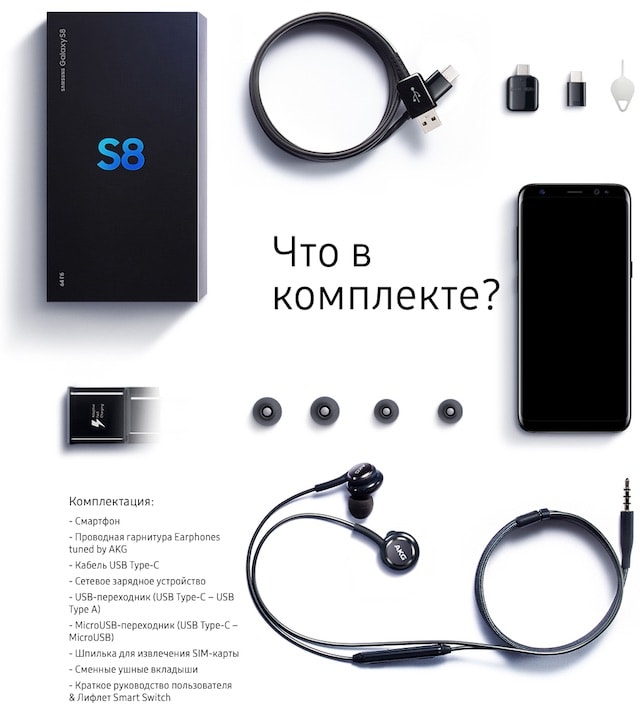

Galaxy S8 and Galaxy S8 Plus presentation in 10 minutes:
For fans of the Samsung brand, another holiday has come, two wonderful smartphones will appear on sale at once - Samsung Galaxy S8 and Galaxy S8 +. Followers of the Galaxy S7 and direct competitors to the Apple iPhone 7, both devices are worthy of their owners. Convenient design and the powerful hardware of the Galaxy S8 is impressive, which is worth talking about in more detail.
Design and interface
Touching and swiping, pinching and spreading your fingers - all this is included in the properties of the touchscreen interface. Changing apps is improved by 3D Touch technology that distinguishes the force of finger pressure (Peek, Pop). All electronics are housed in a durable glass body, with a display diagonal of 5.8 inches. The front panel almost entirely belongs to the screen, the edges of which are rounded even on the side edges. A small strip is left on top, on which you can see the eye of the main camera at 12 megapixels and a double flash LED. The rear panel houses an 8 megapixel front camera, a flash and a biometric scanner. Below is the brand's signature. By color Samsung Galaxy S8 will be available in only three versions: dark black, orchid gray and silver. But even this choice is quite enough not to miss the moment of purchase.
The innovation of the device is the use of docking stations DeX, connected to which is carried out by cable USB Type-C... The appearance of additional HDMI outputs and two USB ports significantly expand the functionality of the gadget, like a PC. Another useful assistant is the Bixby option - a voice command assistant.
Operating systems and more
The Android platform, even of the latest generation, is somewhat different in content from the "apple" indicators of iOS, in some moments even surpassing its competitor. The proprietary processor (for Russia) is represented by the Exynos 8895 brand, for the USA it will be replaced by Qualcomm's Snapdragon 835. According to its main parameters, it is designed to work random access memory in 4 GB, and the main one will not exceed 64 GB. Expansion through a microchip 128/256 GB is allowed. Responsibility for the graphics support is assigned to the Mali G71 accelerator, which is quite enough for high-quality images not only text information, but also photo and video material. High-speed performance is also possible thanks to the availability of universal Flash Storage, and with the built-in Generation of the second version.
Color
Determining the type of device (phone or smartphone?) Is quite simple. If you need a simple and inexpensive device for calls and SMS, it is recommended to opt for a telephone. A smartphone is more expensive, but it offers a wide variety of options: games, videos, the Internet, thousands of programs for all occasions. However, its battery life is significantly shorter than that of a simple phone.General characteristics
A type
MST (Magnetic Secure Transmission) is a technology that allows you to pay with a phone with a tied by credit card even on those terminals in the store that do not support contactless payments. The phone uses a built-in induction loop to simulate the rental of a card in the terminal.
yes Weight 155 g Dimensions (WxHxT) 68.1x148.9x8 mmScreen
Screen type color AMOLED, touch A type touch screen multitouch, capacitive Diagonal 5.8 inches. Curved screen is Image size 2960x1440 Pixels Per Inch (PPI) 568 Automatic screen rotation there is Scratch resistant glass there isMultimedia capabilities
Rear camera 12 MP Flash rear, LED Rear camera functions autofocus, optical stabilization Rear Camera Aperture F / 1.7 Video recording there is Max. video resolution 3840x2160 Max. video frame rate 30 frames / s Front-camera yes, 8 million pixels. Audio MP3, AAC, WAV, WMA Headphone jack 3.5 mmConnection
Standard
There are several basic standards cellular that are supported by modern phones. On the territory of Russia, the GSM standard is used almost everywhere. For high-speed data transmission, 3G and 4G LTE standards are used - the highest speed of the existing standards. Glossary of Terms for the Mobile Phones Category
GSM 900/1800/1900, 3G, 4G LTE, LTE-A Cat. 16, VoLTE Interfaces
Almost all modern smartphones have Wi-Fi and USB interfaces. Bluetooth and IRDA are less common. Wi-Fi is used to connect to the internet. USB is used to connect the phone to a computer. Many phones also have Bluetooth. It is used to connect wireless headphone, to connect the phone to wireless speakers as well as for transferring files. A smartphone equipped with an IRDA interface can be used as universal remote control Remote Control Glossary of Terms by Category Mobile Phones
Wi-Fi 802.11ac, Bluetooth 5.0, USB, ANT +, NFC Satellite navigation
Built-in GPS modules and GLONASS allow you to determine the coordinates of the phone using signals from satellites. In the absence of GPS modern smartphone can determine its own location based on signals from base stations cellular operator... However, finding coordinates based on signals from satellites is usually much more accurate.
GPS / GLONASS / BeiDouMemory and processor
CPU
V modern telephones and smartphones usually use special processors - SoC (System on Chip, system on a chip), which, in addition to the processor itself, are located graphics core, memory controller, controller of input-output devices, etc. Therefore, the processor largely determines the set of functions and performance of the device. Glossary of terms for the category Mobile phones
Qualcomm Snapdragon 835 MSM8998 Number of processor cores 8 Video processor Adreno 540 Built-in memory
Built-in memory is used to store programs, music, photos, movies. The amount of built-in memory largely determines the cost of the device. If your phone does not have a memory card slot, then it is recommended that you select the model with more internal memory.
64 GB RAM size 4 GB Memory card slot
Memory cards allow you to expand your phone's memory. They can be used to store programs, music, photos, movies. Usually, SD format cards (SDHC, SDXC) are used. If your phone does not have a memory card slot, then it is recommended that you select the model with more internal memory.
yes, up to 256 GB (combined with a slot for a second SIM card) there isAdditional Information
Roskachestvo assessment 4.541 RAW support Yes Package Contents smartphone, USB cable Type-C, AKG Headphones, Sim Extraction Tool, Charger, USB connector, Micro USB connector Peculiarities audio - support for UHQ 32-bit Corning Gorilla Glass 5; Dual Pixel technology; Gigabit LTE, Gigabit Wi-Fi; processor: Qualcomm Snapdragon 835 or Samsung Exynos 8895 depending on the market, graphics accelerator: Adreno 540 or Mali-G71 MP20 depending on the processor; water protection - IP68 Date of announcement 2017-03-29 Sales start date 2017-04-21Before buying ask about technical specifications and a complete set by the seller



